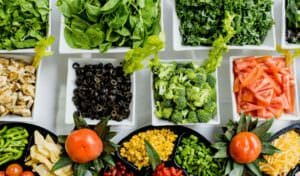Are you stuck in a food rut? Same thing, week in, week out? Have you lost touch with nature and the natural growing cycle of our food? If so, you are not alone. Most of us don’t have the time or the energy to actually stop and think about where our food comes from these days. Perhaps you are bored with food and eating for eating’s sake rather than eating for health.
If I were to ask you about your food intake, would it be lacking in variety? Is your shopping basket filled with the same four or five fruits and vegetables each week? Is lunch a choice between one or two recurrent options?
Maybe you do consciously try to eat with the seasons, following local growing patterns and choosing fruit and vegetables when they are at their natural best? Perhaps you even make the effort to grow some of your own produce. (Lucky you!)
It takes a bit of effort to eat seasonally these days but it might be worth it.
At the risk of sounding old…
In my lifetime I have noticed a distinct change in the availability of fresh fruit and vegetables throughout the year. Now, almost any fruit and vegetable can be found all year round if you look hard enough (and are prepared to pay a bit more).
When I was young (a long, long time ago), I waited with salivating expectation for the summer fruits to come in. We had a plum tree, a passionfruit vine, grapefruit, raspberries and tomatoes growing in the garden. I can vividly remember watching the fruit form and ripen, waiting for the day when mum would let me start picking them. And we would go out and check for newly ripened fruit each day over the holidays. (Sometimes the raspberries didn’t even make it into the house.) Have you ever enjoyed that experience of eating fruit straight from the plant?
I worry that the younger generations may have lost some of this knowledge of how and where our food comes from so it is great to see some schools introducing vegie gardens.
Now, with hothouses, cool stores, early harvesting and artificial ripening, air freight, global economies etc it feels like we have lost touch with the seasons and the natural rhythms of the earth. And perhaps, as a result, we have lost the benefits of growing our own or buying local, seasonal produce or even enjoying the art of preserving food for the off-season.
I know some people think that it’s convenient to be able to buy cherries or tomatoes all year round but eating with the seasons has some advantages.
The advantages of eating with the seasons
Maybe you can think of some others, but start with these:
- a smaller carbon footprint as food has not been shipped in from interstate or overseas
- improved flavour and nutritional content as a result of growing naturally with the season instead of artificially or even months earlier and then stored for later sale as the nutrient levels slowly decline (some of the apples you see in the supermarket can be a year old!)
- you save money, as produce is generally cheaper when it is at its most abundant and grown without the need for expensive artificial assistance
- you are supporting the local economy and local farmers
- increased variety in your diet instead of buying the same things every week out of habit
- eating foods that are best suited to your seasonal needs (think cooling cucumbers and juicy watermelon in the heat of summer or oranges rich in vitamin C for winter).
How can this make you happy?
What does this mean for you:
- you feel good about making a small contribution to the environment and your local economy
- the pleasure you get from eating a meal improves with the flavour of the food
- you are eating food that is at its nutritional peak (which is great for your body and your brain) so you get “more bang for your buck”
- you save money to spend on other things
- better variety means less risk of running low in the key vitamins and minerals required for optimal health.
Where do you start?
One of the best ways to familiarise yourself with seasonal fruit and vegetables is to shop at your local market. Farmer’s markets are particularly good for this type of inspiration. And if your supermarket is a bit limited in variety, look for a local greengrocer or Asian grocer. These smaller, usually independent, shops often have more variety than some of the large chains.
In addition, when you are shopping at the supermarket, read the label on the produce. Pay attention to where it has come from. Is your asparagus local or from Mexico? Has it been shipped from interstate?
If there is a sunny spot at home, experiment with growing your own…even if it is as simple as a pot of parsley or chives.
If you want to challenge yourself to get out of a rut, set an aspiration of trying one new vegetable or fruit a month and look for produce as it is coming into season.
If you would like more guidance on how to broaden your food choices in line with your palate or dietary needs, I’m here to help.





